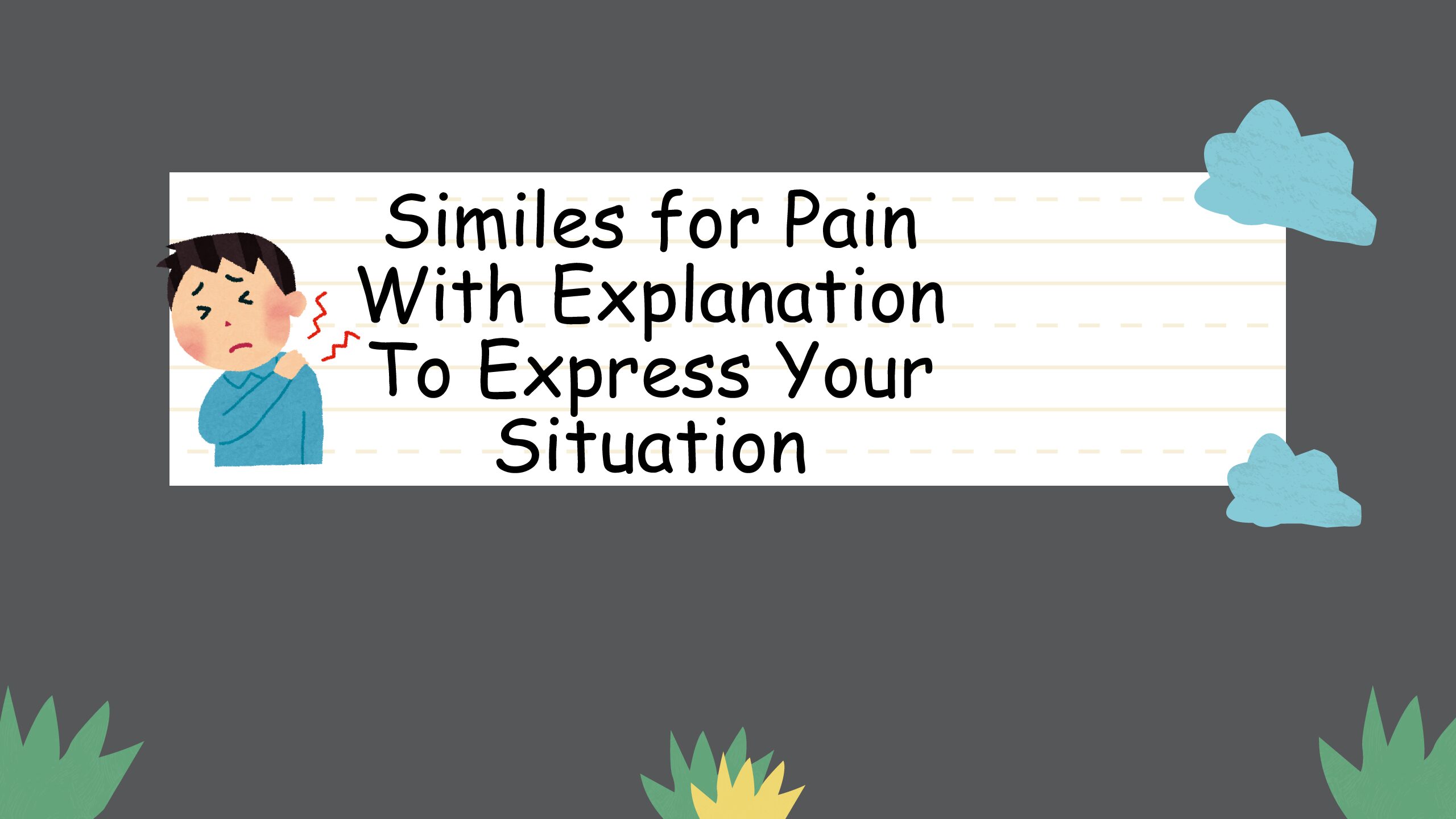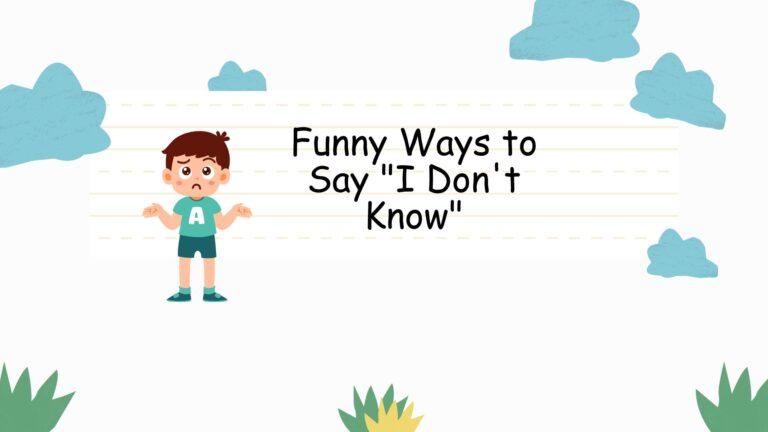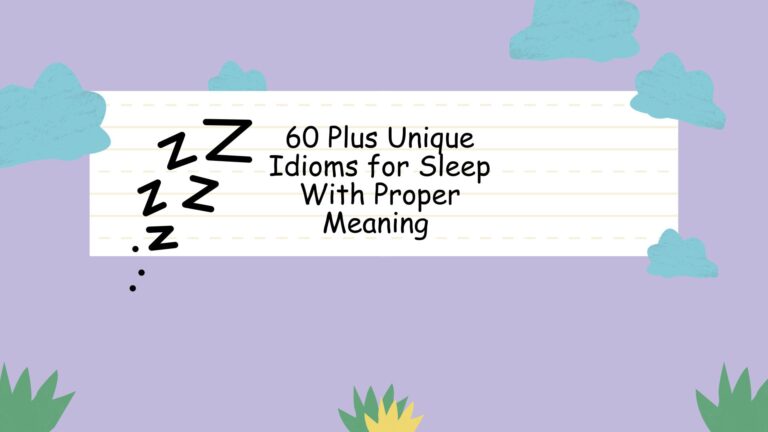
Other Ways to Say “I Understand Your Situation”: A Comprehensive Guide
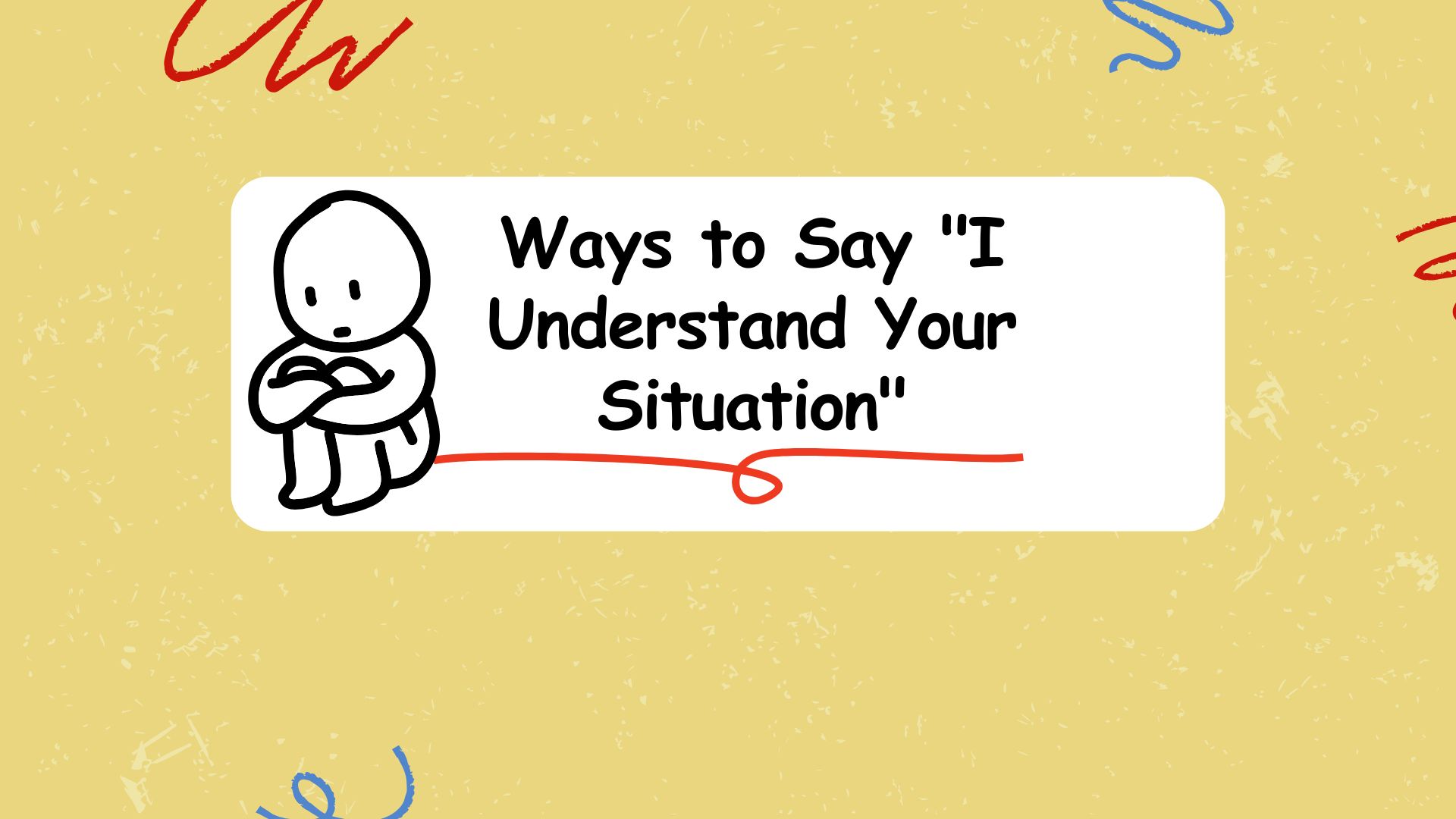
Expressing empathy and understanding is a crucial skill in effective communication. Saying “I understand your situation” is a common way to convey this, but it can sometimes sound repetitive or lack genuine feeling. This article explores a variety of alternative phrases and expressions that allow you to communicate your understanding more effectively and empathetically. Whether you’re a student, a professional, or simply looking to improve your communication skills, this guide will provide you with a wealth of options to express your empathy in a more nuanced and impactful way.
This article will delve into the different nuances of expressing understanding, providing examples and explanations to help you choose the most appropriate phrase for any given situation. We will cover a range of expressions, from formal to informal, and explore how to use them effectively in both written and spoken communication. By the end of this article, you will have a comprehensive understanding of how to convey empathy and understanding in a variety of ways, enhancing your ability to connect with others and build stronger relationships.
Table of Contents
- Introduction
- Definition of Empathy and Understanding
- Structural Breakdown of Empathy Phrases
- Types and Categories of Empathy Phrases
- Examples of Empathy Phrases
- Usage Rules and Considerations
- Common Mistakes to Avoid
- Practice Exercises
- Advanced Topics in Expressing Empathy
- Frequently Asked Questions
- Conclusion
Definition of Empathy and Understanding
Empathy is the ability to understand and share the feelings of another. It involves putting yourself in someone else’s shoes and recognizing their emotions, thoughts, and experiences as if they were your own. This goes beyond simply acknowledging someone’s situation; it involves feeling what they feel and understanding their perspective on a deeper level.
Understanding, in this context, refers to the cognitive aspect of empathy. It means grasping the facts, circumstances, and reasons behind someone’s situation. While empathy involves feeling, understanding involves knowing and comprehending. Together, empathy and understanding form the basis for compassionate communication and strong interpersonal relationships.
The effective use of phrases communicating both empathy and understanding allows for more genuine and meaningful interactions. The ability to articulate these concepts is a valuable asset in personal and professional settings.
Structural Breakdown of Empathy Phrases
Empathy phrases often follow a simple structure, but variations can make them more impactful. The basic structure typically includes:
- Acknowledgment of the situation: Recognizing what the person is going through.
- Expression of understanding or empathy: Showing that you comprehend their feelings.
- Optional: Offer of support or a related sentiment: Providing encouragement or assistance.
For example, a phrase like “That sounds incredibly difficult, and I can only imagine how stressed you must be” follows this structure. “That sounds incredibly difficult” acknowledges the situation, “I can only imagine how stressed you must be” expresses understanding, and the entire phrase conveys empathy.
Variations may include starting with a question to show engagement (e.g., “Are you feeling overwhelmed by this?”), using stronger emotional language (e.g., “I’m truly sorry to hear that”), or adding a personal touch (e.g., “I remember a time when I felt similarly…”). Understanding this structural framework allows you to create your own unique and heartfelt expressions of empathy.
Types and Categories of Empathy Phrases
There are various ways to categorize empathetic phrases, each serving a slightly different purpose. Here are some key categories:
Acknowledgment
These phrases simply acknowledge the other person’s situation without necessarily delving into their feelings. They show that you’ve heard them and understand the basic facts.
Validation
Validation phrases go a step further by validating the other person’s feelings. They communicate that their emotions are normal and understandable given the circumstances.
Shared Experience
These phrases draw on your own experiences to show that you can relate to what the other person is going through. However, it’s crucial to avoid making the conversation about yourself; the focus should remain on the other person.
Offering Support
These phrases offer practical or emotional support. They let the other person know that you’re there for them and willing to help in any way you can.
Showing Perspective
These phrases demonstrate that you are trying to see things from the other person’s viewpoint and understand their challenges.
Examples of Empathy Phrases
Below you will find a number of examples of empathy phrases, divided by category. Understanding the nuances in each category will help you communicate more effectively.
Acknowledgment Examples
These phrases acknowledge the situation and show you’re listening. They are a good starting point for expressing empathy.
| Phrase | Context |
|---|---|
| “I hear what you’re saying.” | During a conversation when someone is explaining a problem. |
| “I understand that this is a difficult time.” | When someone is going through a personal hardship. |
| “I see that you’re dealing with a lot.” | When someone is juggling multiple responsibilities. |
| “I recognize the challenges you’re facing.” | When someone is struggling with a complex issue. |
| “I understand you’re feeling frustrated.” | When someone is expressing frustration. |
| “I understand the pressure you’re under.” | When someone is dealing with work-related stress. |
| “I acknowledge that this is not easy.” | When someone is facing a tough situation. |
| “I understand the situation is complex.” | When dealing with a complicated issue. |
| “I hear you loud and clear.” | During a discussion to show you are attentive. |
| “I understand what you’re telling me.” | Confirming comprehension of a message. |
| “I get where you’re coming from.” | When someone is explaining their point of view. |
| “I understand this has been a long process.” | When someone has been working on something for a while. |
| “I realize you’ve put a lot of effort into this.” | Acknowledging someone’s hard work. |
| “I understand that change is difficult.” | When someone is adapting to new circumstances. |
| “I hear your concerns.” | When someone is expressing worries. |
| “I understand you’re disappointed.” | When someone has experienced a setback. |
| “I realize this is a setback for you.” | Acknowledging a temporary failure. |
| “I understand it’s a significant adjustment.” | When someone is adapting to a new routine. |
| “I follow what you’re saying.” | When someone is explaining something complex. |
| “I understand that you’re overwhelmed.” | When someone feels they have too much to handle. |
| “I understand you are under a lot of pressure.” | When acknowledging a stressful period. |
| “I understand the gravity of the situation.” | When the issue is serious. |

Validation Examples
These phrases validate the other person’s feelings and show that their emotions are understandable.
| Phrase | Context |
|---|---|
| “That sounds incredibly frustrating.” | When someone is dealing with a difficult problem. |
| “It’s understandable that you’re feeling this way.” | When someone is expressing a strong emotion. |
| “I can see why you’re upset.” | When someone is visibly angry or sad. |
| “Your feelings are completely valid.” | When someone is questioning their own emotions. |
| “It’s natural to feel that way in this situation.” | When someone is experiencing a common reaction. |
| “Anyone would feel the same way.” | When someone is unsure if their reaction is normal. |
| “That would make anyone angry/sad/frustrated.” | When validating a specific emotion. |
| “It makes sense that you’re feeling overwhelmed.” | When someone has a lot on their plate. |
| “It’s okay to feel however you’re feeling.” | When someone is suppressing their emotions. |
| “You have every right to feel that way.” | When someone is doubting their own feelings. |
| “Your reaction is perfectly reasonable.” | When reassuring someone about their response. |
| “I’d probably feel the same way if I were in your shoes.” | Showing you are considering their perspective. |
| “It’s understandable that you’re feeling stressed.” | When someone is dealing with a stressful situation. |
| “Your concerns are completely justified.” | When someone is expressing valid worries. |
| “It’s normal to feel uncertain in this situation.” | When someone is unsure about the future. |
| “I understand why you’re feeling hesitant.” | When someone is reluctant to take action. |
| “Your feelings are completely justified.” | When someone’s feelings are backed by circumstances. |
| “It’s perfectly normal to feel scared.” | When someone is expressing fear. |
| “It’s understandable to be disappointed.” | When someone’s expectations were not met. |
| “I can see why you’d be worried.” | When someone has legitimate concerns. |
| “I understand why you’d be hesitant to proceed.” | When someone is cautious about moving forward. |
| “It’s valid that you feel the need to take things slow.” | When someone is expressing a desire to proceed carefully. |
Shared Experience Examples
These phrases draw on your own experiences to show you can relate. Use these carefully to keep the focus on the other person.
| Phrase | Context |
|---|---|
| “I’ve been in a similar situation, and I know how tough it can be.” | When you’ve faced a similar challenge. |
| “I understand what you’re going through; I went through something similar myself.” | When you have personal experience with the situation. |
| “I can relate to that feeling; I felt the same way when…” | When you’ve experienced a similar emotion. |
| “Something like that happened to me once, and it was incredibly difficult.” | When you want to share a relevant experience. |
| “I remember feeling the same way when I was in your position.” | When you can empathize based on past experiences. |
| “I know what it’s like to feel that overwhelmed.” | Sharing similar feelings of being overwhelmed. |
| “I’ve had similar experiences with that, so I know how frustrating it can be.” | When you can understand the frustration involved. |
| “I can relate to that; I experienced something similar last year.” | When drawing parallels to past experiences. |
| “I’ve been there, and it’s not easy.” | When you want to show empathy and understanding. |
| “I went through something similar, and it took a long time to recover.” | When you want to share your recovery journey. |
| “I understand what it’s like to feel lost and confused.” | When someone is expressing confusion. |
| “I’ve been through something similar, and I’m happy to share what I learned.” | Offering insights from your own experience. |
| “I can relate to that; I felt the same way when I lost my job.” | Sharing a similar experience with job loss. |
| “I remember feeling the same way when I had to make a tough decision.” | When you can relate to a difficult choice. |
| “I’ve had similar challenges, and I know how disheartening it can be.” | When you can understand the discouragement involved. |
| “I went through something similar, and it helped to talk about it.” | Encouraging the person to share their feelings. |
| “I know what it’s like to feel that kind of pressure.” | Sharing similar experiences with high-pressure situations. |
| “I’ve been in a similar situation, and I found it helpful to…” | Offering a suggestion based on your experience. |
| “I can relate to the feeling of being stuck.” | When someone is expressing feeling trapped. |
| “I’ve also felt that way when things don’t go as planned.” | When acknowledging disappointment. |
| “I know what it’s like to feel burned out.” | Sharing similar experiences of burnout. |
| “I understand the feeling of not knowing where to start.” | When someone is feeling overwhelmed by a task. |
Offering Support Examples
These phrases offer practical or emotional support, showing you’re there for the person.
| Phrase | Context |
|---|---|
| “I’m here for you if you need anything.” | Offering general support. |
| “Is there anything I can do to help?” | Offering practical assistance. |
| “I’m happy to listen if you want to talk.” | Offering emotional support. |
| “Let me know if you need anything at all.” | Reiterating your willingness to help. |
| “I’m here to support you through this.” | Offering ongoing support. |
| “How can I best support you right now?” | Seeking specific guidance on how to help. |
| “I’m willing to help in any way I can.” | Expressing your commitment to helping. |
| “Don’t hesitate to reach out if you need anything.” | Encouraging the person to ask for help. |
| “I’m in your corner; let me know how I can assist.” | Offering unwavering support. |
| “I’m here to listen without judgment.” | Offering a safe space to talk. |
| “I’m happy to help you brainstorm solutions.” | Offering practical problem-solving assistance. |
| “I’m here to offer a shoulder to cry on.” | Offering emotional comfort. |
| “I’m available if you need someone to talk to.” | Offering your time and attention. |
| “I’m ready to help in any way you think would be useful.” | Being flexible in your support. |
| “I’m here to offer a fresh perspective if you need it.” | Offering a new viewpoint. |
| “I am willing to help you find resources that might assist you.” | Offering assistance in finding helpful materials. |
| “Lean on me if you need support.” | Offering to be a source of strength. |
| “I’m here to help you process this.” | Offering assistance in understanding the situation. |
| “I will be here for you during this difficult time.” | Reinforcing your constant presence. |
| “I’m ready to help you find a path forward.” | Offering assistance in finding solutions. |
Showing Perspective Examples
These phrases show you’re trying to understand things from the other person’s viewpoint.
| Phrase | Context |
|---|---|
| “I can only imagine how difficult that must be.” | Acknowledging the difficulty of the situation. |
| “I’m trying to put myself in your shoes.” | Showing your effort to understand their perspective. |
| “I’m trying to understand what you’re going through.” | Expressing your desire to comprehend their experience. |
| “I’m trying to see things from your point of view.” | Showing your effort to consider their viewpoint. |
| “I’m doing my best to understand your perspective.” | Reiterating your commitment to understanding. |
| “Help me understand what this feels like for you.” | Seeking clarification to better understand. |
| “Can you help me understand your perspective on this?” | Specifically asking for their viewpoint. |
| “I am really trying to understand what you’re going through.” | Emphasizing your sincere effort to comprehend. |
| “I’m putting myself in your shoes to better understand.” | Visualizing their experience to gain insight. |
| “I’m trying to see things from your angle.” | Showing effort to consider their perspective. |
| “I’m trying to understand this from your perspective.” | Focusing on their viewpoint to understand. |
| “I’m trying to understand how this looks from where you stand.” | Showing effort to understand their perspective. |
| “What is this like for you?” | Seeking to understand the emotional impact of the situation. |
| “Walk me through your thinking.” | Asking for clarification on their reasoning. |
| “Help me understand how this is affecting you.” | Seeking to understand the emotional impact. |
| “I am trying to understand this from where you’re standing.” | Showing effort to understand their position. |
| “What does this feel like for you?” | Seeking to understand the emotional experience. |
| “Help me get a sense of the impact this is having.” | Seeking to understand the effect of the situation. |
| “Can you explain what this experience is like for you?” | Seeking a full explanation of their perspective. |
| “I’m interested in understanding what it’s like to be in your position.” | Expressing genuine interest in their situation. |
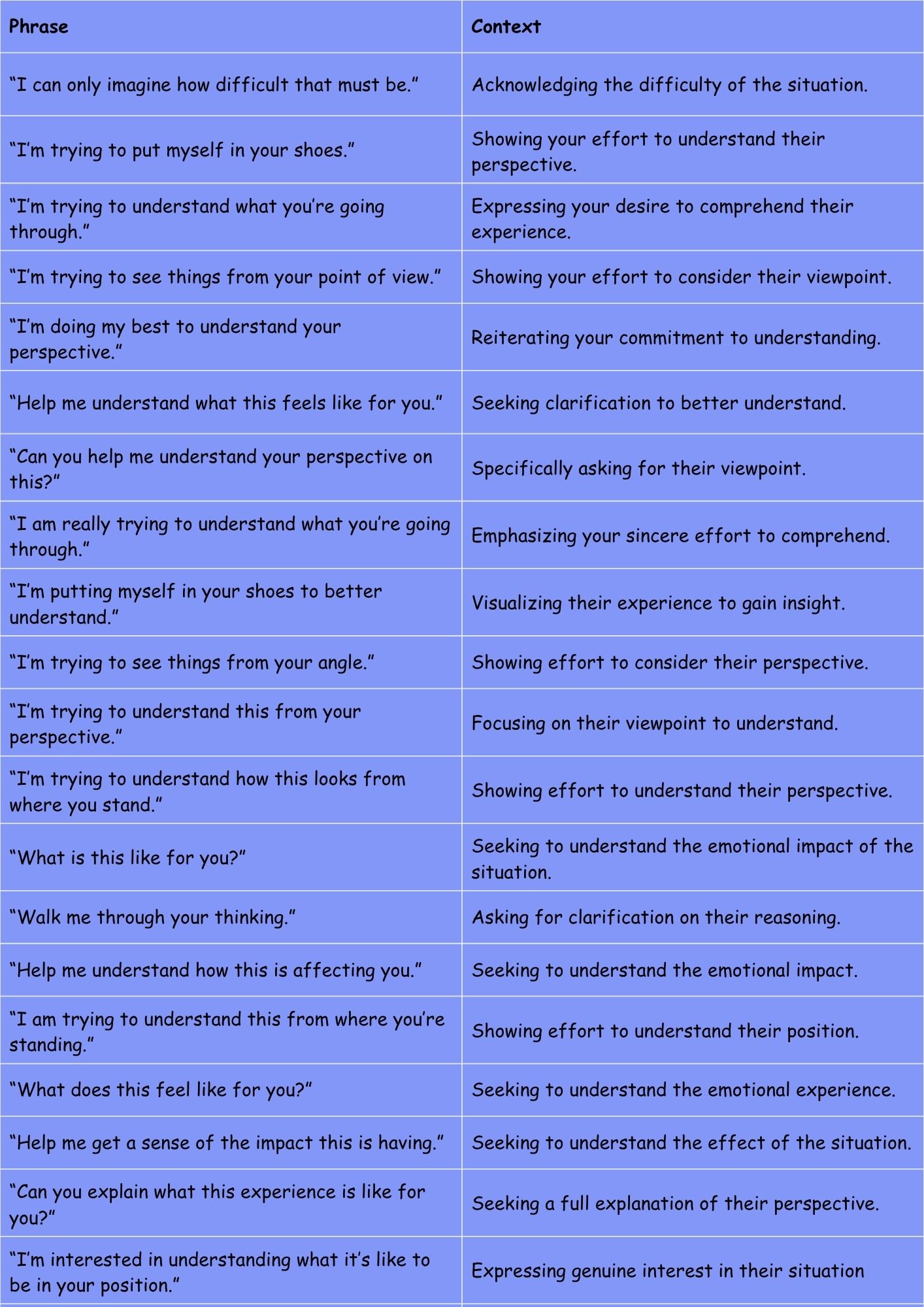
Usage Rules and Considerations
While these phrases can be powerful tools for expressing empathy, it’s crucial to use them appropriately. Here are some key considerations:
- Be Genuine: Empathy must be sincere. People can often detect insincerity, which can damage trust.
- Focus on the Other Person: Avoid making the conversation about yourself. Shared experiences should be used sparingly and only to show you understand.
- Listen Actively: Empathy requires active listening. Pay attention to what the other person is saying, both verbally and nonverbally.
- Avoid Judgment: Refrain from judging or criticizing the other person’s feelings or actions.
- Respect Boundaries: Be mindful of personal boundaries. Don’t push someone to share more than they’re comfortable with.
- Consider the Context: The appropriate phrase will vary depending on the situation and your relationship with the person.
- Use Nonverbal Cues: Empathy is communicated not only through words but also through body language, facial expressions, and tone of voice.
- Be Culturally Sensitive: Different cultures may have different norms for expressing empathy. Be aware of these differences.
- Avoid Giving Unsolicited Advice: Unless asked, avoid giving advice. Sometimes, people simply need to be heard and understood.
By following these guidelines, you can ensure that your attempts to express empathy are well-received and contribute to stronger relationships.
Common Mistakes to Avoid
Even with good intentions, it’s easy to make mistakes when trying to express empathy. Here are some common pitfalls to avoid:
| Mistake | Correct Example | Incorrect Example |
|---|---|---|
| Minimizing the situation: Downplaying the significance of the other person’s experience. | “That sounds incredibly difficult.” | “It could be worse.” |
| Offering unsolicited advice: Giving advice when the person just wants to be heard. | “I’m here to listen if you want to talk.” | “You should just do this…” |
| Making it about yourself: Shifting the focus of the conversation to your own experiences. | “I can relate to that feeling.” (followed by active listening) | “That happened to me too, and it was way worse.” |
| Using clichés: Relying on generic phrases that lack sincerity. | “I’m truly sorry to hear that.” | “I know how you feel.” (without further explanation) |
| Judging or criticizing: Expressing disapproval of the other person’s feelings or actions. | “Your feelings are completely valid.” | “You shouldn’t feel that way.” |
| Offering false reassurance: Providing empty promises or platitudes. | “I’m here to support you through this.” | “Everything will be okay.” (without any basis) |
| Being dismissive: Ignoring or invalidating the other person’s feelings. | “I understand that you’re upset.” | “You’re overreacting.” |
| Offering empty platitudes: Saying things that sound good but lack substance. | “I’m here to help you find a solution.” | “Just stay positive.” |
| Interrupting or talking over: Not allowing the person to fully express themselves. | Active listening with nods and verbal affirmations. | Interrupting to offer your own story or advice. |
By avoiding these common mistakes, you can ensure that your attempts to express empathy are genuine and helpful.
Practice Exercises
Test your understanding of empathy phrases with these exercises. Choose the most appropriate empathetic response for each scenario.
| Scenario | Possible Responses | Correct Answer |
|---|---|---|
| A colleague tells you they’re feeling overwhelmed with their workload. | a) “Everyone feels that way sometimes.” b) “I understand you’re feeling overwhelmed. Is there anything I can do to help lighten your load?” c) “Just try to stay positive.” | b) “I understand you’re feeling overwhelmed. Is there anything I can do to help lighten your load?” |
| A friend shares that they’re going through a difficult breakup. | a) “You’ll find someone else.” b) “I’m here for you if you need to talk. Breakups are never easy.” c) “At least you’re free now.” | b) “I’m here for you if you need to talk. Breakups are never easy.” |
| A family member says they’re feeling anxious about an upcoming medical procedure. | a) “Don’t worry, everything will be fine.” b) “It’s understandable that you’re feeling anxious. Is there anything I can do to help you prepare?” c) “Just try to relax.” | b) “It’s understandable that you’re feeling anxious. Is there anything I can do to help you prepare?” |
| Someone tells you they failed an important exam. | a) “You can always take it again.” b) “I understand you’re disappointed. I’m here to help you study if you want.” c) “It’s just one exam.” | b) “I understand you’re disappointed. I’m here to help you study if you want.” |
| A teammate expresses frustration with a project. | a) “Just get over it.” b) “I see you’re frustrated. What are the biggest challenges you’re facing?” c) “It’s not that bad.” | b) “I see you’re frustrated. What are the biggest challenges you’re facing?” |
| A friend says they are feeling burnt out. | a) “You just need a vacation.” b) “I know what it is like to feel burnt out. What steps are you taking to address it?” c) “It’s all in your head.” | b) “I know what it is like to feel burnt out. What steps are you taking to address it?” |
| A colleague shares they are feeling overwhelmed with their new responsibilities. | a) “You’ll get used to it.” b) “I understand you’re feeling overwhelmed. Let’s break down your tasks together.” c) “Just try to manage your time better.” | b) “I understand you’re feeling overwhelmed. Let’s break down your tasks together.” |
| Someone shares they are feeling lost and confused. | a) “You’ll figure it out eventually.” b) “I understand what it’s like to feel lost and confused. Can you tell me more about what’s going on?” c) “Just keep moving forward.” | b) “I understand what it’s like to feel lost and confused. Can you tell me more about what’s going on?” |
| A family member expresses disappointment about a missed opportunity. | a) “There will be other opportunities.” b) “I understand you’re feeling disappointed. Let’s explore new chances.” c) “Just don’t dwell on it.” | b) “I understand you’re feeling disappointed. Let’s explore new chances.” |
| A friend tells you they are feeling stuck in their career. | a) “Change is always possible.” b) “I can relate to the feeling of being stuck. What are some things you’ve considered trying?” c) “Just be patient.” | b) “I can relate to the feeling of being stuck. What are some things you’ve considered trying?” |
Advanced Topics in Expressing Empathy
Beyond basic phrases and usage, there are more nuanced aspects of expressing empathy.
Cultural Sensitivity
Empathy is not a one-size-fits-all concept. Different cultures have different norms for expressing emotions and providing support. What is considered empathetic in one culture may be seen as intrusive or inappropriate in another. For example, in some cultures, direct eye contact is a sign of respect and attentiveness, while in others, it may be considered disrespectful. Similarly, physical touch, such as a hug, may be comforting in some cultures but unwelcome in others. Therefore, it’s crucial to be aware of these cultural differences and adapt your communication style accordingly. Researching cultural norms and being observant of nonverbal cues can help you navigate these nuances effectively.
Nonverbal Communication
While words are important, nonverbal communication plays a crucial role in expressing empathy. Your body language, facial expressions, and tone of voice can either enhance or undermine your verbal message. Maintaining eye contact (when culturally appropriate), nodding to show understanding, and using a warm and sincere tone of voice can all contribute to conveying empathy. Conversely, crossing your arms, avoiding eye contact, or speaking in a monotone can signal disinterest or insincerity. Pay attention to your nonverbal cues and ensure they align with your verbal message to create a cohesive and empathetic communication style. Mirroring the other person’s body language (subtly) can also help establish rapport and demonstrate understanding.
Frequently Asked Questions
- What’s the difference between empathy and sympathy?Empathy involves understanding and sharing the feelings of another, putting yourself in their shoes. Sympathy, on the other hand, involves feeling sorry for someone, often from a distance. Empathy is about connection, while sympathy can create separation.
- How can I show empathy if I haven’t experienced the same situation?You don’t need to have had the exact same experience to show empathy. Focus on understanding the other person’s feelings and perspective. Ask open-ended questions, listen actively, and validate their emotions.
- Is it okay to offer advice when someone is sharing a difficult situation?Unless asked, it’s generally best to avoid giving advice. People often need to be heard and understood more than they need solutions. If you’re unsure, ask if they’re looking for advice or just want to vent.
- How can I avoid making the conversation about myself when expressing empathy?Keep the focus on the other person. Use “I” statements sparingly and only to show you understand. Avoid sharing your own experiences in detail; instead, focus on validating their feelings and offering support.
- What if I don’t know what to say?It’s okay to simply acknowledge the situation and express your support. Saying something like “I’m so sorry you’re going through this” or “I’m here for you if you need anything” can be enough.
- How do I express empathy in writing?Use clear and concise language, avoid jargon or clichés, and focus on validating the other person’s feelings. Use phrases like “I understand that this must be difficult” or “I can only imagine how you’re feeling.” Pay attention to your tone and ensure it’s sincere and supportive.
- What if someone is being unreasonable or difficult?Even in challenging situations, it’s possible to show empathy. Try to understand their underlying emotions and acknowledge their perspective, even if you don’t agree with their actions. Set boundaries and protect yourself from abuse, but strive to communicate with compassion.
- How can I improve my empathy skills?Practice active listening, pay attention to nonverbal cues, and try to see things from other people’s perspectives. Read books, watch movies, and engage in conversations that expose you to different experiences and viewpoints. Reflect on your own emotions and how you react to different situations.
Conclusion
Mastering the art of expressing empathy is a valuable skill that can enhance your relationships, improve your communication
skills, and create a more compassionate world. By understanding the different types of empathy phrases, practicing their usage, and avoiding common mistakes, you can become a more effective and empathetic communicator. Remember to be genuine, listen actively, and focus on the other person’s feelings and perspective. With practice and awareness, you can transform your interactions and build stronger, more meaningful connections with those around you.

